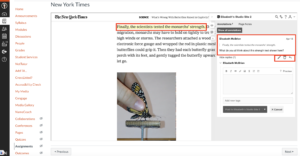The idea that students learn best when they have the opportunity to apply what they are learning to real-world contexts is the basis of Experiential Learning Theory (ELT). Learning by doing is at its core, and as a high-impact practice, there is increasingly more emphasis on experiential learning in higher education. There is plenty of evidence that supports the benefits of this type of learning. It affords students an opportunity to connect knowledge to authentic situations and increases learner autonomy, motivation, and overall satisfaction (Kolb and Kolb, 2018). Many OSU Ecampus Courses feature such experiences. In fact, OSU’s Honors College requires all courses to include experiential learning components, and this is increasingly the case across disciplines at OSU.
What does experiential learning look like?

Many of us may think of community engagement, project-based learning, or practicums when we consider what constitutes an experiential learning experience. While these are solid examples of ELT in practice, experiential learning can take many forms across learning environments. David Kolb describes experiential learning as a four-stage process in his cycle of learning (Kolb and Kolb, 2018). According to Kolb, learning is a process where knowledge is created through the transformation of experience. Students can engage with the cycle at any point in the experience as long as they engage with all four stages. The flexibility of hybrid and online learning presents rich possibilities for incorporating this process. The four stages of Kolb’s experiential learning process include:
- Concrete learning: engage in a new experience or critically interpret a past experience.
- Reflective observation: use experience and background knowledge to understand the relevance or meaning of the experience.
- Abstract conceptualization: gain a new understanding of the experience by adjusting thinking based on reflection.
- Active experimentation: engage experimentally by applying new insights to the situation in a practical way.
Kolb’s theory is not without limitations in that it does not provide clear answers about how collaboration between learners affects reflection, and it doesn’t account for learning that occurs without reflection (Psychology, 2022). While his model isn’t the final word on all of the ways learners make sense of the world, it does provide a good starting point for understanding and designing effective real-world learning opportunities.
What makes a good experiential learning experience?
Regardless of the activity, both the experience and the learning are fundamental in experiential learning scenarios, and the ongoing engagement of both the instructor and the student is critical. In experiential environments, students take ownership of their learning process by taking a more active role such as in posing questions, experimenting, and constructing meaning through their persistent participation in the experience. The role of the instructor, on the other hand, is to ensure that the experience is of high quality and in alignment with the stated learning outcomes while also supporting the learner to develop autonomy in using the principles of experiential learning as defined by The National Society of Experiential Education (NSEE).
Eight Principles of Good Practice for All Experiential Learning Activities
- Intention: the activity is structured around a formal process and the purpose and rationale for why the activity was chosen is transparent and clear to students.
- Preparedness and planning: students understand expectations for engaging in the learning experience and have the necessary background knowledge and preparation to participate in the planned learning with support throughout the process.
- Authenticity: the learning experience is relevant and designed in response to an authentic context or situation in collaboration with those affected by it.
- Reflection: the experience is transformative and allows for knowledge discovery through a process of making and testing decisions around expected or observed outcomes and through consideration of assumptions and implications related to prior and present learning.
- Orientation and training: learner support and guidance include sufficient background preparation needed for successful achievement of learning outcomes.
- Monitoring and continuous improvement: students receive continuous feedback and support to enhance the learning experience and ensure achievement of learning outcomes.
- Assessment and evaluation: students receive helpful and timely feedback from the instructor and any external facilitators, and monitoring and adjustments to process are made as appropriate to ensure achievement of outcomes.
- Acknowledgement: All students and external stakeholders or facilitators are recognized for their work, progress, and contribution to the experience.
Experiential Learning in OSU Ecampus Courses
The following examples illustrate a small selection of the many creative experiential learning opportunities OSU faculty developers have incorporated into their online and hybrid courses in collaboration with Ecampus instructional designers.
- Build a community of writers online. Students read, critique, write, edit, revise, and share original pieces of creative writing. An activity modeled after the Iowa Writer’s Workshop and implemented in a creative writing course.
- Discover and Promote well-being in an Online Community. Students in a philosophy class engage in activities in their local community and online to talk about topics around well-being. They then reflect on those experiences and dialogue before compiling a “happiness toolkit” and sharing it with peers.
- Explore health and fitness assessment techniques used to measure cardiovascular health. Through a series of hands-on labs, students monitor volunteers’ exercise regimes and calculate cardiovascular fitness values to make recommendations based on the data collected.
- Collaborate in a team to study and analyze management case studies. Students work through complex and ambiguous problems to solve a workplace challenge and find solutions before participating in an authentic human resources simulation.
- Write and perform music. Students in a performance-based music course write and perform original pieces of music.
- Examine poverty and its effect on students’ local communities. Students complete a public health scavenger hunt guided by specific questions, reflection, and peer collaboration. They then create a guide describing public health issues and potential solutions.
- Investigate the necessary conditions for designing effective teams and work groups, including best practices and processes needed for maximum productivity, strategies to resolve common issues in teams, and methods to evaluate team performance. Students then apply their learning by leading a team in real life.
- Analyze and conduct research on a local public health issue. Students partner with community organizations in their area to identify needs and apply principles of public health to authentic contexts.
The list is far from exhaustive. New courses featuring experiential learning are currently in development across disciplines. Faculty interested in learning more about how to get started learning by doing in hybrid and online courses can learn more by checking out the Ecampus experiential learning resources page.
Resources
Eight Principles of Good Practice for All Experiential Learning Activities. (n.d.). Retrieved January 19, 2023, from https://www.nsee.org/index.php?option=com_content
Inside Higher Ed, Roberts, J., & Welton, A. (2022, August 3). The foundational best practices in experiential learning. Inside Higher Ed.
Kolb, AY & Kolb, DA 2017, The experiential educator: Principles and practices of experiential learning, EBLS Press, Kaunakakai, HI.
Kolb, A., & Kolb, D. (2018). Eight important things to know about the experiential learning cycle.
Proposing Experiential Learning Opportunities (ELOS). (n.d.). Center for Integrative and Experiential Learning, Revised March 2019.
Psychology, P. (2022, December 6). Experiential Learning (Definition + Examples) | Practical Psychology. Practical Psychology.




 In 2019, I worked with an instructor developing a biochemistry/biophysics course for Ecampus. The instructor loved the peer-to-peer interaction intended for discussions, but was discouraged by the often lackluster exchange commonly demonstrated in the posts. She wanted to liven up these conversations, not only to increase the strength of the community but also to have an impact on the value of the learning that took place.
In 2019, I worked with an instructor developing a biochemistry/biophysics course for Ecampus. The instructor loved the peer-to-peer interaction intended for discussions, but was discouraged by the often lackluster exchange commonly demonstrated in the posts. She wanted to liven up these conversations, not only to increase the strength of the community but also to have an impact on the value of the learning that took place. From this list of 5 to 10 conversation starters that give breadth to the topics, the students can choose which they want to respond to, often selecting what’s of greatest interest to them. These posts could be anything related to the topic or question, so students are free to approach from any perspective or direction.
From this list of 5 to 10 conversation starters that give breadth to the topics, the students can choose which they want to respond to, often selecting what’s of greatest interest to them. These posts could be anything related to the topic or question, so students are free to approach from any perspective or direction. In the new version, students first answer and submit solutions to the homework individually, and this initial phase is graded on proper application of concepts, rather than on the correctness of the answer. Next, students work together in small groups of 3 or 4 to discuss the same set of problems and, as a group, arrive at consensus of the correct answers.
In the new version, students first answer and submit solutions to the homework individually, and this initial phase is graded on proper application of concepts, rather than on the correctness of the answer. Next, students work together in small groups of 3 or 4 to discuss the same set of problems and, as a group, arrive at consensus of the correct answers. These are just two simple but ingenious ways to reformat classic forms of interaction and assessment.
These are just two simple but ingenious ways to reformat classic forms of interaction and assessment.









 Why Use Active Learning?
Why Use Active Learning?
 In 2004, a skeptical Michael Prince (2004) researched the then-current literature on active learning to determine whether it offered consideration for engineering. He found that many active learning recommendations directly conflicted with historical engineering teaching practices. Methods like breaking lectures into small, topic-specific segments, interspersing lecture with discussion, using problem-based scenarios, or grouping students for collaborative learning were uncommon. Ultimately, Prince reluctantly concluded that the bulk of research evidence indicated that these types of teaching methods might foster better retention and enhance critical thinking.
In 2004, a skeptical Michael Prince (2004) researched the then-current literature on active learning to determine whether it offered consideration for engineering. He found that many active learning recommendations directly conflicted with historical engineering teaching practices. Methods like breaking lectures into small, topic-specific segments, interspersing lecture with discussion, using problem-based scenarios, or grouping students for collaborative learning were uncommon. Ultimately, Prince reluctantly concluded that the bulk of research evidence indicated that these types of teaching methods might foster better retention and enhance critical thinking.
 Design activities that encourage students to work in small groups or collaborate with others.
Design activities that encourage students to work in small groups or collaborate with others. You know the famous quip about pictures, so let’s consider how using a visually-based tool for active-learning can support online learners.
You know the famous quip about pictures, so let’s consider how using a visually-based tool for active-learning can support online learners.  Most classes assign reading to students. Yet reading is a solo activity, so it offers a lower level of active learning. But there are ways to raise reading’s active learning value, with or without technology.
Most classes assign reading to students. Yet reading is a solo activity, so it offers a lower level of active learning. But there are ways to raise reading’s active learning value, with or without technology. If you want to add technology, you can make reading even more active! Using an app called
If you want to add technology, you can make reading even more active! Using an app called